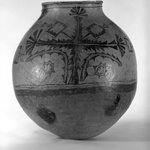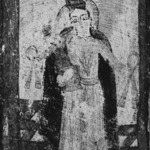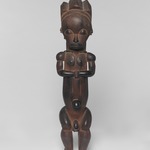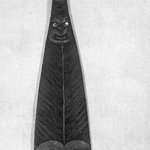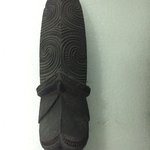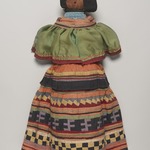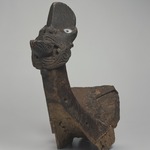
Door lintel (Pare or Korupe)
Arts of the Pacific Islands
Unlike Turner Towers’ purely decorative “stones,” Māori and Yorùbá architectural elements both incorporate distinctive symbols to convey spiritual and secular concepts. This Māori pare (lintel) symbolizes the boundary between the realms of gods linked with war and peace. The openwork motif depicts a female figure with shell eyes (center); at left and right are manaia, hybrid beings that can navigate between human and spiritual realms. The lintel likely topped the entryway or window of a wharenui (meeting house). Other figures surmounted the building’s roof and side posts. These features of the exterior sculptural ensemble projected iwi (tribal) identity into the marae, a multipurpose outdoor gathering space.
CULTURE
Maori
MEDIUM
Wood, pāua shell
DATES
late 18th–early 19th century
DIMENSIONS
13 1/2 x 35 1/8 x 1 7/8 in. (34.3 x 89.2 x 4.8 cm) (show scale)



INSCRIPTIONS
"IX" carved in the back of the head of the central figure; "61.126" occurs twice, once in ink and once in pencil.
COLLECTIONS
Arts of the Pacific Islands
ACCESSION NUMBER
61.126
CREDIT LINE
Frank L. Babbott Fund and Carll H. de Silver Fund
CATALOGUE DESCRIPTION
Maori wood carving of a Korupe or Pare (window or door lintel). The central figure is a female with clasped hands, short legs and a typical grotesque face ornamented with green shell eyes. To either side the wood is carved into nonsymmetrical small swirls etc and two larger manaia figures. The bottom section appears to depict a platform where there is little openwork. The object is carved on the back as well, and there is partial finished detail on the back. There is no presence of a surface coating and the object is not painted.
EXHIBITIONS
MUSEUM LOCATION
This item is not on view
CAPTION
Maori. Door lintel (Pare or Korupe), late 18th–early 19th century. Wood, pāua shell, 13 1/2 x 35 1/8 x 1 7/8 in. (34.3 x 89.2 x 4.8 cm). Brooklyn Museum, Frank L. Babbott Fund and Carll H. de Silver Fund, 61.126. Creative Commons-BY (Photo: , 61.126_PS9.jpg)
IMAGE
overall, 61.126_PS9.jpg., 2019
"CUR" at the beginning of an image file name means that the image was created by a curatorial staff member. These study images may be digital point-and-shoot photographs, when we don\'t yet have high-quality studio photography, or they may be scans of older negatives, slides, or photographic prints, providing historical documentation of the object.
RIGHTS STATEMENT
Creative Commons-BY
You may download and use Brooklyn Museum images of this three-dimensional work in accordance with a Creative Commons license. Fair use, as understood under the United States Copyright Act, may also apply.
Please include caption information from this page and credit the Brooklyn Museum. If you need a high resolution file, please fill out our online application form (charges apply).
For further information about copyright, we recommend resources at the United States Library of Congress, Cornell University, Copyright and Cultural Institutions: Guidelines for U.S. Libraries, Archives, and Museums, and Copyright Watch.
For more information about the Museum's rights project, including how rights types are assigned, please see our blog posts on copyright.
If you have any information regarding this work and rights to it, please contact copyright@brooklynmuseum.org.
RECORD COMPLETENESS
Not every record you will find here is complete. More information is available for some works than for others, and some entries have been updated more recently. Records are frequently reviewed and revised, and we welcome any additional information you might have.

